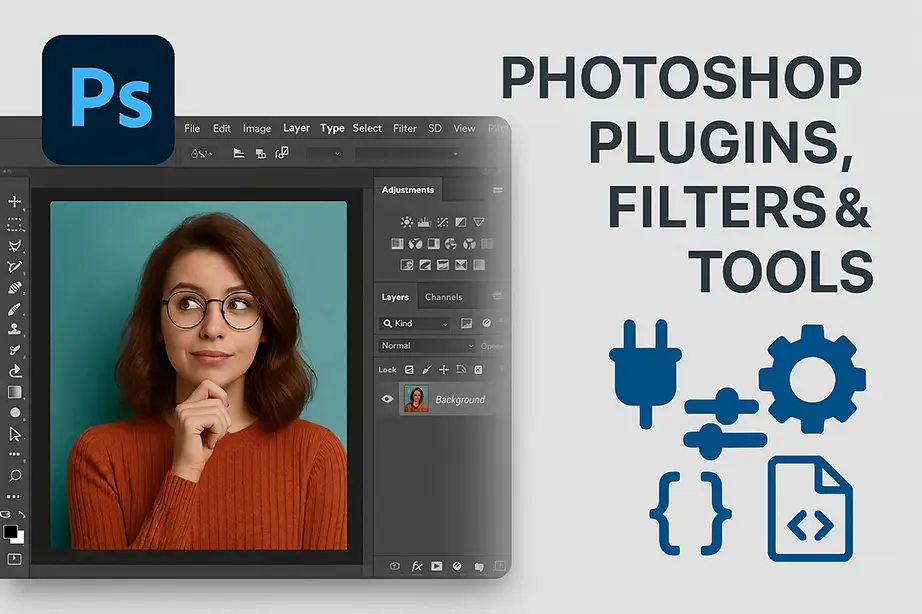
Photoshop Custom Software Development
Whether you need in-app plugins, Photoshop scripts or compute-intense low-level tools; or if you want to integrate the power of Photoshop into your app or service, there’s a developer interface that will fit. Mapsoft provides these services as part of its custom software development solutions.
Transform Your Creative Workflows with Custom Photoshop Plugins and extensions
In today’s competitive creative landscape, efficiency and automation are no longer optional—they’re essential. Custom Adobe Photoshop plugins deliver 30-70% time savings on repetitive tasks while ensuring consistent, professional results across your entire creative pipeline. Whether you’re managing high-volume e-commerce product photography, maintaining brand compliance across global campaigns, or streamlining print production workflows, the right plugin transforms hours of manual work into minutes of automated precision.
With over 30 years of specialized Adobe development experience, Mapsoft has partnered with leading publishing houses, e-commerce platforms, creative agencies, and enterprise marketing teams to build plugins that solve real-world challenges. Our deep understanding of Adobe’s ecosystem—from legacy ExtendScript to cutting-edge UXP technology—ensures your custom plugin integrates seamlessly with existing Creative Cloud workflows while delivering measurable ROI from day one.
Beyond simple automation, our Photoshop plugins and extensions unlock new creative possibilities: AI-powered enhancements, intelligent batch processing, dynamic template systems, and cross-application workflows that connect Photoshop with your broader technology stack. Every plugin we develop is built with your specific needs in mind, ensuring it becomes an indispensable part of your creative process.
CEP, ExtendScript Photoshop scripts
Build classic extensions with CEP using HTML, CSS, and JS. Automate in-app workflows with ExtendScript Photoshop scripts, based on ECMAScript 3. This can be used if backwards combatability with earlier versions of Photoshop of if code needs to be shared with other CC applications that don’t support the new UXP interface photoshop scripting language.
Photoshop API
Use Photoshop, Lightroom, and Sensei together to create web or server-based workflows to cut out images, reflow banner ads, and more.
The Photoshop APIs deliver high-fidelity, low-cost solutions that scale. Get direct access to the engine powering the industry’s most intelligent and scalable photo
UXP Plugin Photoshop scripts API
Build performant plugins (Photoshop scripts) with modern HTML, CSS, and JavaScript. UXP is the next generation of plugin APIs, for Photoshop version 22 and beyond.
With this technology we can build plugins for Adobe® Photoshop versions 22.0 and later. If you need support for earlier versions of Photoshop we can use CEP which is being replaced by UXP.
UXP provides modern JavaScript, a curated selection of UI components, and a more streamlined workflow for plugin developers.
C++ SDK
With this technology we can build powerful, low-level integrations using the C++ SDK. Create filters, provide support for additional image formats, create new selectors, and more. This has been the traditional way of building additional functionality with photoshop for many years. It is possible to combine CEP and a traditional binary plug-in where CEP provides the user interface. This interface would be required for example if multithreading is a requirement in a realtime interface such as in integration into a hardware device such as an interactive whiteboard.
.
Choose the Right Technology for Your Photoshop Plugin
Selecting the optimal development approach ensures your plugin delivers maximum performance, compatibility, and user experience. Our expertise spans all Adobe technologies, allowing us to recommend and implement the perfect solution for your specific requirements.
| Technology | Best For | Performance | Compatibility | Key Advantages |
|---|---|---|---|---|
| UXP Modern | New plugins requiring modern UI, cloud integration, and future-proof architecture | Excellent | Photoshop 2021+ |
|
| CEP Legacy | Existing plugins requiring updates, cross-application workflows, web technology integration | Good | CS6 – CC 2024 |
|
| ExtendScript Automation | Batch processing, workflow automation, cross-Creative Cloud scripting | Good | All versions |
|
| C++ SDK Performance | Pixel manipulation, filters, performance-critical operations, proprietary algorithms | Maximum | All versions |
|
Quick Decision Guide
Starting Fresh?
Choose UXP for modern, future-proof plugins with the best user experience and performance.
Need Speed?
Use C++ SDK when processing millions of pixels or implementing complex image algorithms.
Updating Legacy?
Migrate from CEP to UXP gradually while maintaining compatibility during transition.
